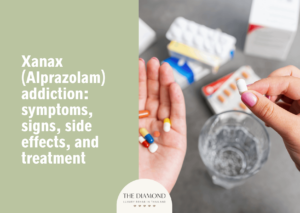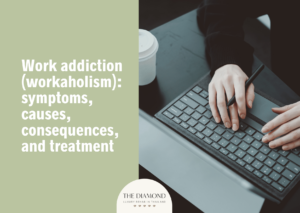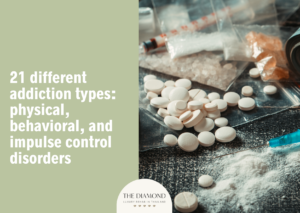Xanax (Alprazolam) addiction: symptoms, signs, side effects, and treatment

Xanax addiction is characterized by an individual’s physical or psychological dependence on the drug, necessitating increasingly high dosages to obtain the same effects. Affected individuals persist in using or seeking more despite harmful consequences.
The symptoms of Xanax addiction include craving for Xanax, drowsiness, increased tolerance, blurred vision, withdrawal symptoms, slurred speech, loss of control and difficulty concentrating.
The signs of Xanax addiction are doctor shopping, neglecting responsibilities, social withdrawal, financial problems, paraphernalia or hidden medication, risk-taking behaviors and legal problems.
The side effects of Xanax addiction include weakness, impaired coordination, flattened mood, dry mouth, nausea and appetite loss, constipation, memory loss and suicidal ideation.
Treatment options for Xanax addiction include medically managed detox, cognitive behavioral therapy (CBT), gradual tapering, motivational interviewing (MI), inpatient treatment, 12-step programs and outpatient treatment programs.
Is Xanax addictive?
Yes, Xanax is highly addictive due to its strong influence on brain chemistry. The drug belongs to the benzodiazepine group, known for slowing neural activity and producing calmness. Various individuals begin using the medication for anxiety or panic disorders, then develop tolerance after repeated use.
Once tolerance forms, larger doses become necessary to feel the same relief. Such dependency progresses into anxiolytic addiction, causing intense cravings and compulsive use. Continued intake frequently leads to physical and psychological dependence, leaving many addicted to Xanax.
According to a continuing education activity by Tobin T. George and Jayson Tripp, titled “Alprazolam” last updated in April 2023, prolonged use of alprazolam, similar to other benzodiazepines, leads to clinically significant physical dependence. Long-term treatment involving high daily doses heightens the risk of dependence and withdrawal symptoms.
What is Xanax?

Xanax is a brand-name prescription drug from the benzodiazepine class of drugs. The medication treats anxiety and panic disorders by influencing brain chemicals responsible for regulating mood and stress.
The drug is known for being fast-acting, providing relief within a short time after ingestion. Xanax boosts gamma-aminobutyric acid (GABA), a neurotransmitter responsible for reducing overstimulation in the brain and producing a calming effect. The formulation is potent, delivering results even in low doses. Xanax is commonly dispensed in tablet form and prescribed for short treatment courses.
How addictive is Xanax?
Xanax is highly addictive. Particularly if taken above recommended dosages, the drug has a significant potential for abuse and dependence. As one of the most habit-forming benzodiazepine drugs available today, alprazolam leads users to rely on increasing doses to feel calm or relaxed.
Habitual misuse affects brain function, compromising normal stress regulation and emotional control. Extended usage results in decreased brain function, including poor concentration, memory issues and slowed reaction time.
The drug’s short duration of action contributes to repeated dosing, intensifying the cycle of dependence. Numerous individuals begin with medical use but progress to harmful consumption once tolerance builds.
What makes Xanax so addictive?
The chemical structure of Xanax, which powerfully alters brain activity and emotional regulation, is what makes it so addictive. The drug acts as a sedative, slowing mental and physical responses while creating a deep sense of calm.
At the same time, Xanax stimulates the pleasure center of the brain, triggering the release of dopamine, a neurotransmitter linked to reward and satisfaction. The impact of drugs on the brain becomes evident as repeated use reinforces the desire to recreate the soothing and euphoric feeling.
Is it possible to take Xanax every day without becoming addicted?
No, it is not possible to take Xanax every day without becoming addicted. Alprazolam, the active ingredient in Xanax, alters brain chemistry in ways that encourage dependence with continuous exposure.
Prolonged Xanax use strengthens psychological reliance, as users begin to associate calmness or relief exclusively with the medication. The attachment increases the risk of addiction and withdrawal once usage stops.
Over time, natural stress regulation and emotional balance weaken as the body relies on external chemical support. Even medically supervised treatment with alprazolam usually limits duration to prevent long-term harm. Dependence risk grows further if doses exceed prescribed levels or are taken more frequently than advised.
Can you overdose on Xanax?
Yes, you can overdose on Xanax. Excessive intake overwhelms the central nervous system, slowing vital functions such as breathing and heart rate. High doses produce extreme drowsiness, confusion and impaired coordination. Severe cases lead to loss of consciousness or coma.
Mixing Xanax with alcohol or opioids greatly increases the danger of respiratory failure and death. Drug overdose occurs when tolerance develops and larger amounts of the medication are consumed to feel relaxed. Emergency treatment involves medical monitoring, airway support and sometimes activated charcoal to reduce absorption.
What are the symptoms of Xanax addiction?
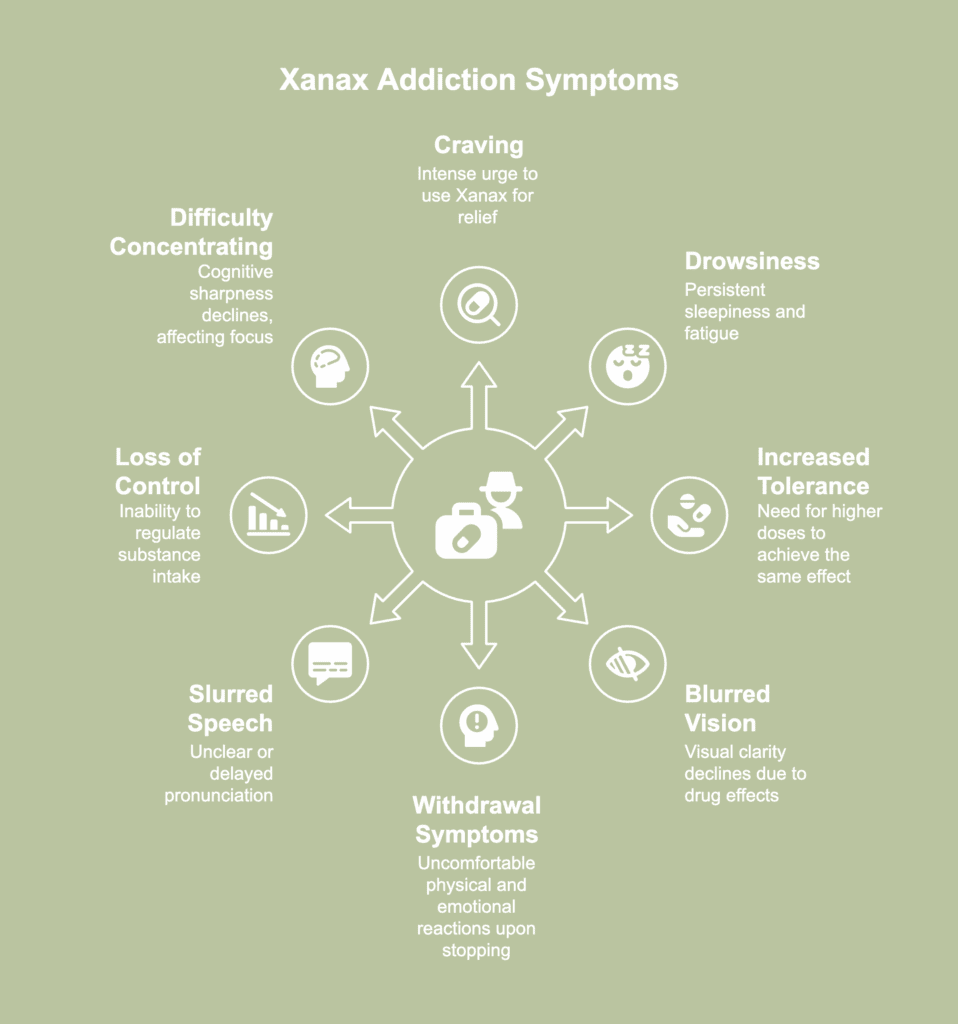
Symptoms of Xanax addiction refer to the sensations and changes personally felt by someone dependent on the drug. The symptoms of Xanax addiction are listed below.
- Craving for Xanax: A strong urge to consume Xanax develops as the brain links the drug with relief and comfort. The individual begins to think about the substance frequently, feeling uneasy without access to the medication. Cravings tend to interrupt daily focus and decision-making, pushing the person to prioritize use over responsibilities.
- Drowsiness: Xanax abuse slows the nervous system, creating persistent sleepiness throughout the day. Routine tasks start feeling demanding due to constant fatigue and low alertness. Concentration wanes, reducing productivity at work or school. The resulting exhaustion interferes with conversations, judgment and even safe driving.
- Increased tolerance: With ongoing exposure, the body begins requiring larger doses to produce the same relaxing effect. The calming sensation once achieved with a small amount becomes difficult to reach. The gradual adaptation fosters a dangerous cycle of escalation, as the person chases the initial relief. Tolerance marks the early stage of dependence and leads to greater physical strain.
- Blurred vision: Visual clarity declines as alprazolam interferes with communication between the brain and eye muscles. Individuals notice double images or trouble focusing on nearby objects. As per a 2022 report by Constable et al., titled “A Review of Ocular Complications Associated with Medications Used for Anxiety, Depression, and Stress,” alprazolam increases the risk of bilateral acute angle-closure glaucoma due to its effect on the sphincter pupillae muscle. The drug’s influence causes the pupil to enlarge, narrowing the space that allows fluid to drain from the eye. Once drainage becomes restricted, pressure rises inside the eye, leading to sudden pain or blurred vision.
- Withdrawal symptoms: When use stops abruptly, the body reacts strongly to the absence of the drug. Uncomfortable symptoms frequently appear during withdrawal. The emotional impact feels overwhelming, making relapse more likely without medical help. Withdrawal symptoms from alprazolam are often stronger than other benzodiazepines and include rebound anxiety, panic attacks, physical distress and in severe cases, delirium and psychosis, according to a 2018 review by Ait-Daoud et al., titled “A Review of Alprazolam Use, Misuse, and Withdrawal.” Such effects still occur despite adherence to the manufacturer’s tapering guidelines.
- Slurred speech: Xanax dependence slows coordination in the muscles responsible for speech, leading to unclear or delayed pronunciation. Words sound heavy, uneven or incomplete during conversations. Communication becomes frustrating for both the speaker and the listener. The issue worsens with higher doses and prolonged exposure.
- Loss of control: Addiction takes away a person’s ability to regulate substance intake or resist urges to use. The sense of self-discipline gradually fades as emotional relief becomes tied to the drug. Many begin taking doses earlier or more often than prescribed, convincing themselves it is necessary to feel stable. The growing compulsion disrupts priorities, relationships and daily functioning.
- Difficulty concentrating: Cognitive sharpness declines as the medication alters attention and memory processing. Mental fog leaves the person feeling detached and less capable of handling daily challenges. A 2023 study by Ritvo et al., called “Long-term consequences of benzodiazepine-induced neurological dysfunction: A survey” revealed among 1,207 respondents, 85.3% experienced difficulty focusing or frequent distraction. Several participants noted symptom persistence after discontinuing benzodiazepines, lasting months or even years. Notably, 76.6% of affirmative responses indicated symptom durations extending for months or a year or more.
What are the signs of Xanax addiction?

Signs of Xanax addiction are outward changes noticed by others in someone suffering from the disorder. The signs of Xanax addiction are listed below.
- Doctor shopping: Individuals with Xanax addiction tend to exaggerate symptoms or fabricate medical issues to secure extra medication. A continuing education activity titled “Prescription of Controlled Substances: Benefits and Risks” last updated by Preuss et al., in July 2025 defined doctor shopping, or prescriber shopping, as the act of deliberately seeking multiple prescriptions for controlled substances such as alprazolam, a Schedule IV medication. Many states now use monitoring systems allowing healthcare professionals to review every prescription issued to each patient, reducing such misuse.
- Neglecting responsibilities: As dependence deepens, personal and professional obligations begin to lose importance. Work performance declines, household duties remain unfinished and relationships weaken due to lack of engagement. The individual’s focus shifts toward obtaining or using the drug rather than meeting commitments. Consistent avoidance of duties signals a loss of balance and discipline.
- Social withdrawal: People addicted to Xanax distance themselves from family and friends to hide consumption habits. Social events or gatherings become uncomfortable due to fear of judgment or exposure. Isolation fosters secrecy, strengthening the emotional bond with the drug instead of human connection.
- Financial problems: Continuous use drains personal savings and disrupts financial stability. Funds meant for bills or necessities are redirected toward purchasing the medication. Mounting debts, unpaid bills or borrowing money become frequent consequences. Financial strain fuels stress and anxiety, further driving substance reliance.
- Paraphernalia or hidden medication: Addicted individuals frequently store pills in unmarked containers or concealed places to avoid discovery. Stashes appear in handbags, drawers or vehicles, showing a deliberate effort to maintain constant access. A 2019 study by Maust et al., titled “Benzodiazepine Use and Misuse Among Adults in the United States” identified alprazolam as the most frequently misused benzodiazepine. Most respondents obtained the drug from friends or relatives, whether given freely, purchased or stolen. Nearly 70% of individuals who misused benzodiazepines named a friend or relative as the main source, while a single clinician ranked second.
- Risk-taking behaviors: Abuse leads to reckless actions endangering health or safety. Driving while sedated, mixing substances or exceeding prescribed doses becomes common. Decision-making grows impulsive as judgment deteriorates under chemical influence. Such behaviors reflect a disregard for consequences in pursuit of relief or euphoria.
- Legal problems: Frequent misuse sometimes results in arrests for possession without prescription or driving under the influence. Encounters with law enforcement become a direct outcome of impaired reasoning and loss of control. Legal disputes potentially extend to employment or custody matters, compounding emotional distress.
What are the side effects of Xanax addiction?
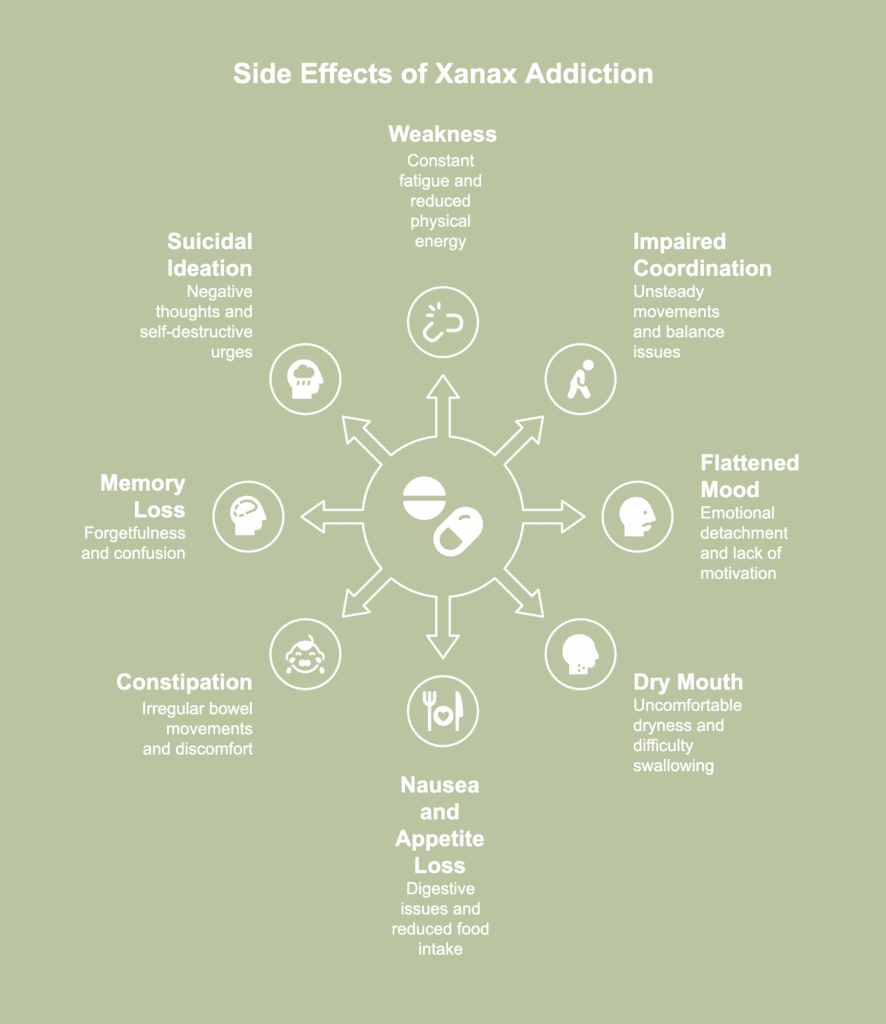
Side effects of Xanax addiction are the outcomes of abusing the medication over an extended period of time. The side effects of Xanax addiction are listed below.
- Weakness: Prolonged Xanax addiction leads to a constant feeling of physical weakness or fatigue. Individuals struggle to perform everyday tasks or feel drained after minimal effort. The sedative properties of Xanax slow physical movement and muscle response, causing reduced energy and endurance.
- Impaired coordination: Motor control becomes unsteady as the drug disrupts communication between the brain and body. Movements lose precision, and balance starts to falter even during simple tasks. According to a 2023 paper by Aitken et al., titled “Acute administration of alprazolam, alcohol and their combination on cognitive performance and mood: A randomised, double-blind, placebo-controlled study,” a 1 mg dose of alprazolam slows reaction time, disrupts coordination and reduces attention span. Acknowledging the significant impact of such medications on daily functioning is vital, particularly for recreational or outpatient users with limited prior exposure.
- Flattened mood: Emotional range narrows, leaving the person detached from joy, sorrow or excitement. Motivation fades as experiences feel hollow and unimportant. The tranquillizing effect of the drug dulls emotional intensity, creating a sense of emptiness shadowing everyday interactions. Relationships begin to suffer as emotional connection becomes difficult to maintain.
- Dry mouth: Reduced saliva flow produces an uncomfortably dry sensation, often accompanied by cracked lips and sore gums. Speaking and swallowing require more effort, adding to daily irritation. A 2023 report by Teoh et al., called “Dry mouth effects from drugs used for depression, anxiety, schizophrenia and bipolar mood disorder in adults: systematic review” revealed psychotropic drugs like alprazolam cause dry mouth, medically known as xerostomia, a concern emphasized in recent reviews of oral side effects reported to pharmaceutical databases like the Monthly Index of Medical Specialties (eMIMs). Among 57 identified medications—spanning antidepressants, antipsychotics, mood stabilisers and anxiolytics—xerostomia emerged as the most prevalent oral symptom, accounting for 91% of all reported cases.
- Nausea and appetite loss: Xanax interferes with digestion, leading to unsettled stomach sensations and a lack of interest in food. Meals start to feel unpleasant or unappealing, leading to reduced intake. Malnutrition slowly develops as nutrient absorption declines and weight decreases. Persistent queasiness eventually undermines both energy levels and immune strength.
- Constipation: Digestive muscles slow significantly, making bowel movements irregular and uncomfortable. Waste accumulates, causing bloating and abdominal cramps. The sedative action of the drug interferes with normal gut rhythm, worsening the problem with extended use. Such digestive disruption becomes a constant source of physical discomfort in affected individuals.
- Memory loss: Cognitive processing weakens, resulting in frequent forgetfulness and confusion during conversations or tasks. The drug’s depressive effect on neural activity disrupts the formation of new memories. A 2023 review by Kameron Kaplan and Holly Christian Hunsberger titled, “Benzodiazepine-induced anterograde amnesia: detrimental side effect to novel study tool” confirmed benzodiazepines have been shown to impair both short-term and long-term memory in humans and rodents, with an especially strong impact on verbal recall, recognition, working memory and spatial memory.
- Suicidal ideation: Chemical imbalance from heavy alprazolam use negatively affects emotional stability, causing despair and hopelessness. Negative thoughts intensify as the brain’s ability to regulate mood deteriorates. Emotional numbness blurs judgment, leading to self-destructive urges and reckless decision-making. Without medical intervention, intrusive thoughts become increasingly dangerous.
How to recognize Xanax addiction?
Recognizing Xanax addiction involves paying close attention to both behavioral and physical alterations in an individual’s daily functioning. Signs include persistent drowsiness, slurred speech, unstable coordination and unpredictable mood shifts.
Individuals tend to engage in reckless actions such as driving after consumption or obtaining multiple prescriptions through doctor shopping. Gradual withdrawal from social circles and neglect of work or family duties further suggest a growing dependence.
Financial difficulties arise as obtaining the drug becomes a priority. Frequent use to relieve withdrawal discomfort deepens the cycle of addiction and makes recovery more difficult.
How to help someone with Xanax addiction?
To help someone with Xanax addiction, remain patient and composed while offering support. Maintaining a calm presence encourages honest communication and reduces defensiveness. Avoid shouting or using harsh words, as aggression drives the person further away instead of motivating change.
Encourage open discussions about how their substance use affects health and relationships. Suggest professional assistance, such as medical detox or therapy, to ensure a safe and structured recovery process. Provide reassurance that seeking help reflects strength, not failure. Support consistent treatment participation and celebrate small milestones to reinforce progress.
What are the Xanax addiction treatment options?
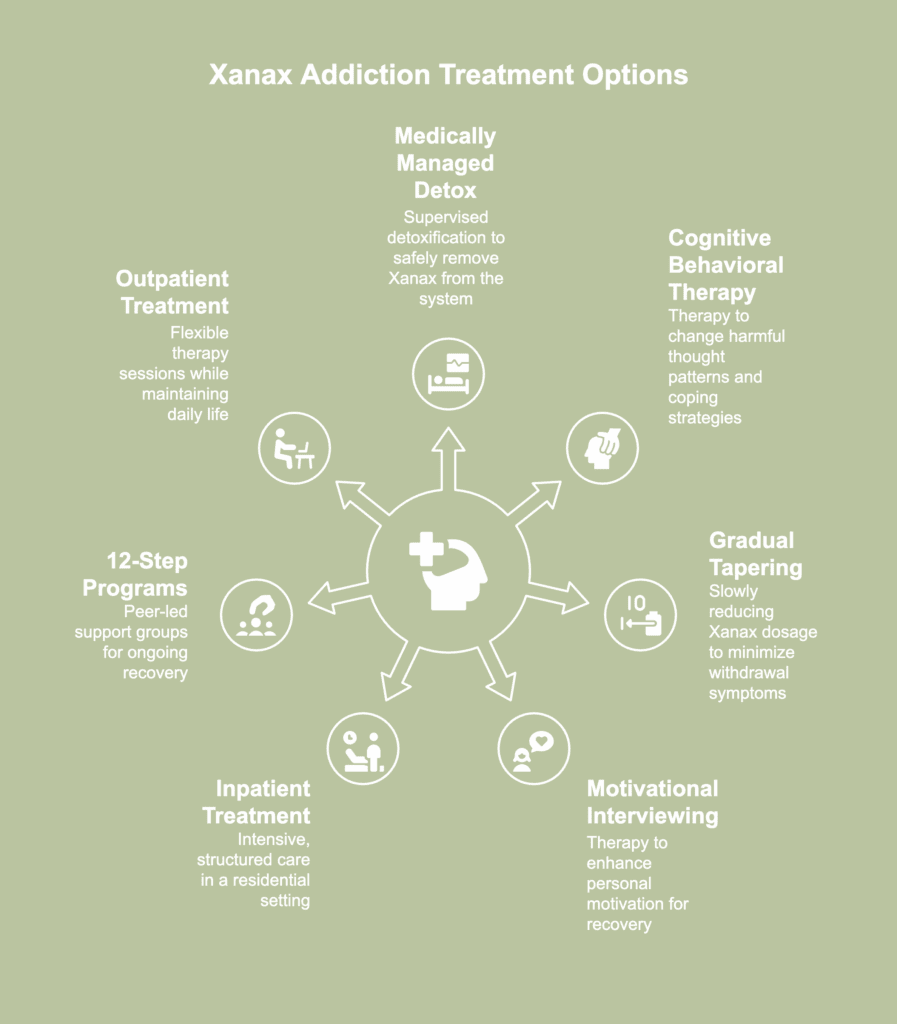
Xanax addiction treatment options pertain to the therapeutic methodologies employed to assist persons in overcoming reliance on Xanax. The most significant Xanax addiction treatment options are listed below.
- Medically managed detox: A medically supervised detox provides a controlled setting for clearing alprazolam from the system under professional care. Medical staff track vital signs and manage symptoms to reduce discomfort and prevent complications. Continuous observation ensures safety, as withdrawal brings intense physical and emotional distress. Drug detoxification prepares the body for further therapy once stability returns.
- Cognitive behavioral therapy (CBT): CBT helps individuals recognize harmful thought patterns sustaining drug dependence. The approach focuses on building healthier coping strategies to replace self-destructive habits. According to a 2021 review by Chapoutot et al., titled “Cognitive Behavioral Therapy and Acceptance and Commitment Therapy for the Discontinuation of Long-Term Benzodiazepine Use in Insomnia and Anxiety Disorders,” when paired with gradual tapering, traditional CBT increases abstinence rates to 70–80% after treatment, with 50–90% maintaining recovery for up to a year. Through easing anxiety and insomnia, CBT strengthens a person’s belief in their capacity to overcome benzodiazepine dependence.
- Gradual tapering: Gradual tapering involves lowering alprazolam doses step by step to lessen withdrawal severity. Health professionals customize the pace to match the person’s physical response and dependency level. According to an article by Brunner et al., called “Joint Clinical Practice Guideline on Benzodiazepine Tapering: Considerations When Risks Outweigh Benefits” published in June 2025, gradual taper is advised when trying to quit benzodiazepines (BZDs), typically lowering the dose by 10–25% every 1–4 weeks, depending on patient tolerance. For short-acting BZDs such as alprazolam, switching to longer-acting options like diazepam helps stabilize withdrawal. Weekly evaluations track symptoms such as anxiety, tremors and sleep disturbance using standard assessment tools.
- Motivational interviewing (MI): Motivational interviewing focuses on strengthening personal motivation for recovery rather than forcing change. Therapists use empathy and reflective listening to help individuals recognize the value of sobriety. The method empowers patients to set achievable goals based on personal readiness. The collaborative style encourages lasting commitment to healthier choices.
- Inpatient treatment: Inpatient programs in drug rehab provide a secure and structured environment away from daily stressors and temptations. Clients receive 24-hour supervision, therapy sessions and medical support. Living within a therapeutic community fosters accountability and emotional healing.
- 12-step programs: 12-step programs offer peer-led support promoting connection and responsibility. Participants follow a structured path of self-reflection, acceptance and amends. Sharing experiences within a group reinforces accountability and reduces isolation. The sense of belonging nurtures hope and encourages ongoing participation in recovery.
- Outpatient treatment programs: Outpatient treatment allows individuals to maintain daily responsibilities while attending scheduled therapy sessions. The flexible format supports recovery without complete separation from work or family life. Sessions usually include counseling, relapse prevention strategies and medication management. The approach suits people with strong support systems and mild dependency levels.
Is rehab effective for Xanax addiction?
Yes, rehab is effective for Xanax addiction when supported with structured care and professional supervision. Inpatient and outpatient programs offer structured settings designed to limit triggers and encourage accountability.
Effective Xanax addiction treatment includes medically assisted detox to ensure safe withdrawal and stabilization. Within a rehab, patients engage in counselling, skill-building and relapse prevention to strengthen recovery.
Inpatient care suits severe dependence, offering round-the-clock monitoring and therapy. Outpatient programs benefit individuals with mild addiction who are able to maintain daily commitments while attending treatment. Both settings encourage consistent progress through counselling, medication management and aftercare planning.
Does Xanax cause a withdrawal effect?
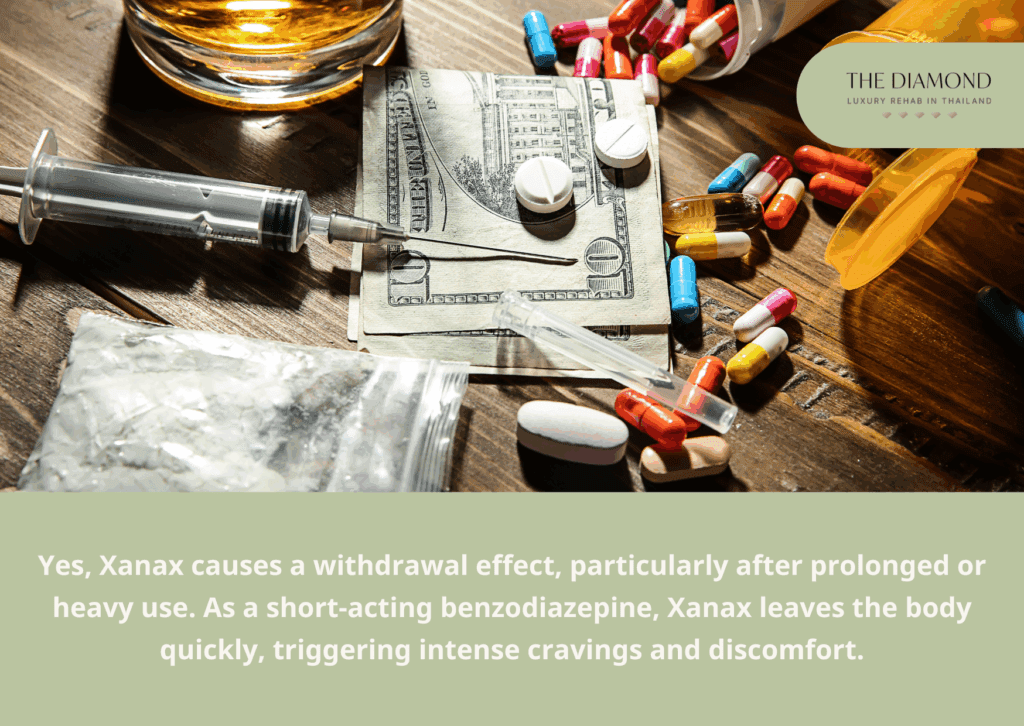
Yes, Xanax causes a withdrawal effect, particularly after prolonged or heavy use. As a short-acting benzodiazepine, Xanax leaves the body quickly, triggering intense cravings and discomfort.
Benzo withdrawal involves symptoms such as anxiety, insomnia, irritability, tremors and muscle pain. In severe cases, individuals experience hallucinations or seizures without proper medical support.
The brain becomes reliant on the drug’s calming influence, so quitting cold turkey is extremely dangerous. Medical supervision during detox helps manage withdrawal symptoms safely and prevents complications. Gradual tapering under professional care reduces shock to the nervous system.
How long does Xanax withdrawal last?
Xanax withdrawal lasts between one and four weeks, depending on dosage, duration of use and individual health. The first symptoms usually appear within a day after the last dose, often beginning with anxiety, restlessness or insomnia.
Discomfort tends to intensify during the first week as the body adjusts to the absence of the drug. Physical issues such as tremors, sweating and muscle tension accompany early stages. Certain individuals experience lingering sensitivity to stress even after the acute phase ends.
As per a 2018 study by Ait-Daoud et al., titled “A Review of Alprazolam Use, Misuse, and Withdrawal,” withdrawal symptoms from alprazolam discontinuation tend to be harsher than those from other benzodiazepines due to the drug’s short half-life, strong potency and affinity for alpha-2 adreno-receptors, which regulate stress and arousal responses. The interaction intensifies rebound anxiety and heightens the severity of withdrawal.








